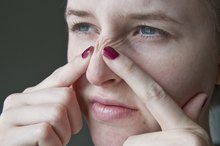How to Prevent Milia in Children's Faces
Milia are small, benign whitish bumps that can develop on various body parts in people of all ages. The two main forms of this condition are primary and secondary milia. While primary milia are very common in newborns and appear mostly on their cheeks and noses, secondary milia can affect older children and adults. In newborns, the condition will clear up by itself in a few weeks and will not require treatment, assures MedlinePlus. Although it may be impossible to prevent primary milia in newborns, parents may attempt these precautionary measures to minimize secondary milia formation on the faces of older children.
Wash your child’s face two to three times a day with warm water and a gentle cleanser. Pat the face dry with a soft towel. This can keep the face clean and skin ducts unblocked.
Creams for the Removal of Milia
Learn More
Use a light and oil-free moisturizer, if you use a moisturizer on your child’s face. Avoid using heavy or oil-based facial products because they may cause skin blockages that can lead to milia formation, suggests the Doctor Good Skin website 4.
Limit your child’s exposure to ultraviolet sun rays which are usually strongest between the mid-morning and afternoon hours. Either keep him indoors or apply an oil-free sunscreen on his face before he goes outdoors during these hours. He should also wear a hat while out in the sun. Excessive sun exposure can cause skin damage, thickening of the dermis and possible development of these facial bumps or cysts.
Dark Pigmentation in the Elbows, Ankles and Inner Thigh
Learn More
Avoid overusing lip balm to moisturize your child’s chapped lips. Some ingredients in certain lip balm products may cause milia to form around the mouth or lip area.
Prevent major trauma or blistering of the dermis on a child's face to minimize the occurrence of milia. If a serious skin trauma, such as a burn, affects sweat ducts, then milia formation may occur.
Tips
Secondary milia can develop in people with certain types of disorders associated with skin blisters such as the condition Porphyria cutanea tarda, according to Skinsight. A defect in a liver enzyme is the cause for Porphyria cutanea tarda.
Related Articles
References
- Skinsight: Milia Conditions, Treatment and Pictures for Parents
- MedlinePlus Medical Encyclopedia: Milia
- Mayo Clinic: Milia: Lifestyles and Home Remedies
- Doctor Good Skin: Skin Disease: Milia: Prevention
- Yahya H. Idiopathic multiple eruptive milia: Report of a case in a Nigerian woman. Niger J Clin Pract. 2018;21(3):395-6. doi:10.4103/njcp.njcp_43_17
- Kutlubay Z, Tanakol A, Engýn B, et al. Newborn skin: common skin problems. Maedica (Buchar). 2017;12(1):42-7.
- Cho E, Cho SH, Lee JD. Idiopathic multiple eruptive milia occurred in unusual sites. Ann Dermatol. 2010;22(4):465-7. doi:10.5021/ad.2010.22.4.465
- Ghosh S, Sangal S. Congenital milia en plaque on scalp. Indian J Dermatol. 2015;60(1):105. doi:10.4103/0019-5154.147871
- Hinen HB, Gathings RM, Shuler M, Wine lee L. Successful treatment of facial milia in an infant with orofaciodigital syndrome type 1. Pediatr Dermatol. 2018;35(1):e88-e89. doi:10.1111/pde.13350
Resources







